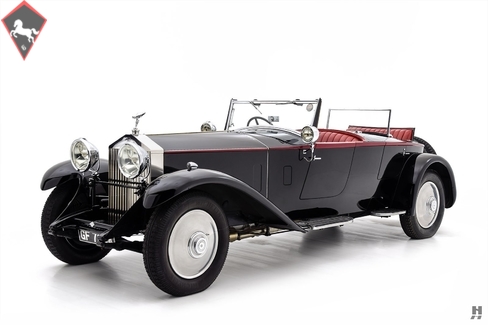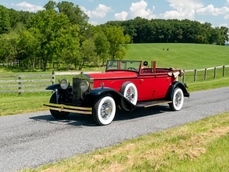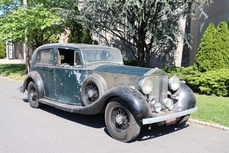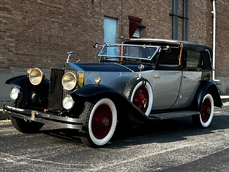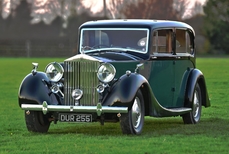Rolls-Royce Phantom II Two Seater Open Sports By Hooper 1930
Allmän beskrivning :
Announced in 1929, the magnificent Phantom II served the role of Rolls-Royce’s flagship model for six years and set the standard for other manufacturers of luxury motorcars the world over. Central to the new car was a new 7,668cc six-cylinder engine that shared only the bore and stroke dimensions with the outgoing Phantom I unit. Key developments included a crossflow cylinder head, separate inlet ports, improved exhaust manifolds and a bump in compression that released an additional 20 horsepower. Rather than boast about output, Rolls-Royce’s marketing department allowed the unparalleled levels of refinement to speak for them. Paired with the marvelous engine was a new chassis and driveline afforded all around better handling, ride quality as well as a lower floor line - much to the delight of coachbuilders who could now fit lower and sleeker bodies at the behest of their clients. Sales of the Phantom II were quite respectable, with 1,545 examples built through 1935.
The great English coachbuilders of the time practiced their craft with the PII chassis, with some more successful and prolific than others. Among the most prestigious was Hooper, established in 1805. From 1833 on, the firm held a Royal Warrant to provide coaches for the Royal Family; an agreement which they sustained for over 110 years. In Hooper’s own words, their coachwork was reserved for “the Royal and the distinguished,” and their extensive portfolio of designs ranges from the sedate to the flamboyant.
Our featured Rolls-Royce Phantom II is a truly striking example, wearing one-off and distinctly sporting Two Seater Open Sports coachwork by Hooper. A well-documented example, chassis number 23GN has worn this evocative body from new, ordered by the noted English businessman, sportsman, and philanthropist Sir Julien Cahn. RROC records show he ordered this Phantom II on October 18, 1929. It arrived at Hooper at the end of February 1930, and the installation of the coachwork (Body Number 7351) was completed by April 1930. It was delivered to Sir Julian later that month, registered as GF7844. Cahn took over his family’s furnishing business and expanding aggressively, ultimately controlling more than 300 stores across England. His philanthropy led to his knighting in 1929, and he was made a baronet in 1934 for his charity work. He is best known for his keen interest and skill in fox hunting and especially in the sport of cricket, where he enjoyed a successful career as both a player and team owner.
Sir Julian's love of sport is reflected in his choice of coachwork for the Phantom II. While most Phantoms were clothed with elegant, formal bodies, this car is quite the opposite. The body is trim and clean, with a purposeful appearance befitting a wealthy sportsman. The design features a lovely boat tail treatment at the rear, abbreviated front wings, and step plates in lieu of full running boards. Bumpers were omitted from new, and dual rear-mounted spares lend a fabulous character, making the car appear even lower and longer than it already is. While officially designated a two-seater, the unique dual-cowl design can accommodate four passengers thanks to a discreet rear cockpit with a separate folding windscreen. When not in use, the seat and windshield fold to create a flat rear deck. Should inclement weather strike, unique individual hoods can be erected for both the front and rear compartments.
Sir Julien Cahn retained his beloved Phantom II until the outbreak of war when he dutifully donated it to The Ministry of War Transport. After the war, it was common practice to return cars to their original owners, but as Sir Julien passed away in 1944, the Rolls-Royce was sold to H.S.N Adams in 1946. R.D. Linford was the next owner, acquiring 23GN in 1957. In 1964, it was obtained by J.L. Mackinlay who was an active R.R.E.C. member and who regularly enjoyed the car for many years. In 1988, 23GN was still in England, owned by broker and colorful character Charles Howard. In 1991, Howard sold it to an American collector, Ken Behring. It remained in Behring’s collection through 1997 when it was sold to David Hogue, who then commissioned a comprehensive, professional restoration, adorning the car with the striking black and scarlet livery it wears today.
Following its magnificent restoration, the Phantom II debuted at the 1997 Pebble Beach Concours d’Elegance, where it received the coveted Lucius Beebe Memorial Trophy. It subsequently earned a CCCA Senior award in 2003 and was invited to return to the lawn at Pebble in 2018. This car appears in Lawrence Dalton’s Coachwork on Rolls Royce (p. 128), in Charles Howard’s “An AUTObiography (p.194) and in the December 2005 issues of Road & Track magazine which covered the inaugural 1,500-mile Pebble Beach Motoring Classic, a copy of which is included in the file.
Over the years, 23GN has been well maintained, with the restoration maturing slightly through regular use and enjoyment. The black paintwork is gorgeous, and the body finely detailed with period-correct accessories including Lucas King of the Road headlamps and spot lamps. Polished alloy wheel discs and black wall Michelin tires maintain the purposeful and sporty appearance. Front and rear cockpits are trimmed in matching red hides, with exquisite woodwork and restored original instruments adorning the dash. The rear compartment houses a set of factory PII tools. In addition, front and rear weather equipment and copies of the chassis card and build records will be included in the sale.
In approximately 2014, 23GN returned to England where Graham Moss of R.C. Moss performed a mechanical overhaul. In the interest of comfortable and reliable touring, a heavy duty Laycock P-Type overdrive unit mates with the original four-speed manual gearbox. The under-bonnet presentation is good. A unique and distinguished motorcar with documented provenance, this exciting Phantom II will be a welcome addition to the most discerning collections, sure to provide countless miles of motoring pleasure.
Offers welcomed and trades considered
https://hymanltd.com/vehicles/6331
1930 Rolls-Royce Phantom II Two Seater Open Sports By Hooper is listed såld on ClassicDigest in St. Louis by Mark Hyman for Ej prissatt.
Fakta i bilen
Karosstyp : Personbil Märke : Rolls-Royce Modell : Phantom II Modellversion : Two Seater Open Sports By Hooper Motorvolym : 0.0 Årsmodell : 1930 Läge : Missouri
Såld
Information om säljaren
Såld
People who viewed this Rolls-Royce Phantom II also viewed similar Rolls-Royce listed at ClassicDigest
Other cars listed for sale by this dealer
om Rolls-Royce
Nåväl, damer och herrar, idag dyker vi in i den lysande historien om ett varumärke som alltid har inneburit själva essensen av brittisk lyx och hantverk - Rolls-Royce.Vår historia börjar vid förra sekelskiftet när två visionärer, Charles Rolls och Henry Royce, beslutade att gå samman. År 1904 föddes den allra första Rolls-Royce, Rolls-Royce 10 hp. Det var en blygsam början för ett företag som skulle omdefiniera bilens överlägsenhet.
Men det var inte förrän 1907 som Rolls-Royce verkligen gjorde sin stämpel med introduktionen av Silver Ghost. Den hyllades som "Världens bästa bil" och satte gulstandard för lyxkörning. Med sin tystlåtna motor och utsökta hantverk var det en symbol för överflöd och förfining.
1920-talet förde oss Rolls-Royce Phantom I, en ikon för sin tid. Det var den första Rolls-Royce med en 6-cylindrig motor och lade grunden för den legendariska Phantom-serien. Detta var eran när Maharadjor i Indien beställde specialbyggda Rolls-Royces som var inget mindre än bilpalats.
Snabbspola till efterkrigsåren, och vi har Silver Cloud, en symbol för det brittiska efterkrigsoptimismen. Silver Cloud var elegans personifierad, med sina flytande linjer och handgjorda interiörer. Det var valet för kungligheter, kändisar och kaptenar inom industrin.
Men om vi pratar om Rolls-Royces lyx i sin fulländning, är det Rolls-Royce Phantom VI som graciöst dök upp i våra liv från 1968 till 1991. Det här var en bil som gjorde uttalandet att "om du måste fråga priset kan du inte ha råd det." Anpassning var nyckelordet, och Phantom VI var en canvas för världens rikaste för att uttrycka sina unika smaker.
Nu är det omöjligt att diskutera Rolls-Royce utan att nämna Rolls-Royce Corniche. Producerad från 1971 till 1995 var det en cabriolet- och coupéversion av Silver Shadow. Corniche var den ultimata grand tourern, en bil för dem som ville färdas över kontinenter i absolut lyx.
Men, ack, även de mäktigaste måste möta sin nedgång, och Rolls-Royce var inget undantag. Företaget genomgick ekonomiska prövningar på 1970- och 80-talen, vilket ledde till övertagandet av Vickers plc. Sedan kom den kontroversiella ägandeperioden av BMW och Volkswagen, som delade entusiasterna.
Rolls-Royce återfick fotfästet under BMW-ägande, och det nya millenniet förde oss Rolls-Royce Phantom VII, en återgång till företagets rötter av kompromisslös lyx. Phantom VII var ett vittnesmål om brittisk ingenjörskonst och hantverk.
Och det, damer och herrar, för oss till idag. Rolls-Royce fortsätter att producera några av de mest overdådiga, specialtillverkade fordon på planeten, en symbol för brittisk imperium som inte har falnat med tiden. Anden av Sir Henry Royce och Charles Rolls lever vidare i varje bil som bär Spirit of Ecstasy, ett vittnesmål om det bestående arvet av brittisk bilöverlägsenhet.
